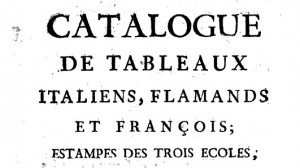Art Crossing Borders: The Birth of an Integrated Art Market in the Age of Nation States (Europe, ca. 1780-1914)
 Europe and its Worlds: Cultural Mobility in, to and from Europe, International Conference at the Radboud University Nijmegen (The Netherlands), 16-18 October 2013
Europe and its Worlds: Cultural Mobility in, to and from Europe, International Conference at the Radboud University Nijmegen (The Netherlands), 16-18 October 2013
Deadline: 20 April 2013
During the long nineteenth century continuing improvements in the road and transportation infrastructure ensured that the local art markets in Europe became connected like never before, both in the proverbial and literal sense of the word. Ever more paintings, art lovers and artistic information crossed regional and national boundaries, culminating in a truly integrated European art market. Paintings increasingly found new destinations in foreign private and public collections, while more and more artists, art lovers and art dealers could freely roam the European continent in their never-ending pursuit of aesthetic pleasure and/or commercial benefit. Information networks equally tightened, allowing dealers and collectors to easily communicate across wide distances and at the same time stay close to the pulse of art scenes abroad.
The increasing internationalisation of the European art world was closely intertwined with a growing importance of the very conceptual categories that this integration seemed to question: artistic and commercial labels referring to nationality, most conspicuously articulated in the division of art production into separate national “schools” in (popular) art historical literature, art criticism, early museum catalogues and, most importantly in this context, auction catalogues and catalogues of contemporary art exhibitions and commercial galleries. Thus, major art dealers imported thousands of paintings from abroad, but often pitched them as typical examples of a national “school”; universal exhibitions introduced foreign artists to local markets, but were also based on a logic of emulative competition along national lines; and artists often sought patronage abroad, but usually preferred nurturing the taste for the foreign in other countries to adapting their own work to foreign taste.
Many of these developments are often glossed over rather quickly, because most histories of the art market, like most histories of art itself, are still written along national lines. The aim of this panel is to tackle this deficit head-on and to contribute in this way to the writing of a global history of the art market, while not losing out of sight the historical impact of the national paradigm that paralleled the market’s integration. This session therefore raises the central research question how the integrating European art market of the long nineteenth century (1780-1914) simultaneously countered and constructed the notion of national painterly “schools”, along the crucial axes of nationalism and internationalism. It thus also addresses the decisive challenge that Europe still faces today: how to harmonize disharmonious local, national and transnational voices.
Please send proposals (max. 400 words) for a 20 minute paper for this session to Jan Dirk Baetens (J.Baetens@let.ru.nl) and/or Dries Lyna (D.Lyna@let.ru.nl). For more information, see http://www.ru.nl/europeanditsworlds/conference/introduction or contact the session convenors.

Leave a Reply
You must be logged in to post a comment.